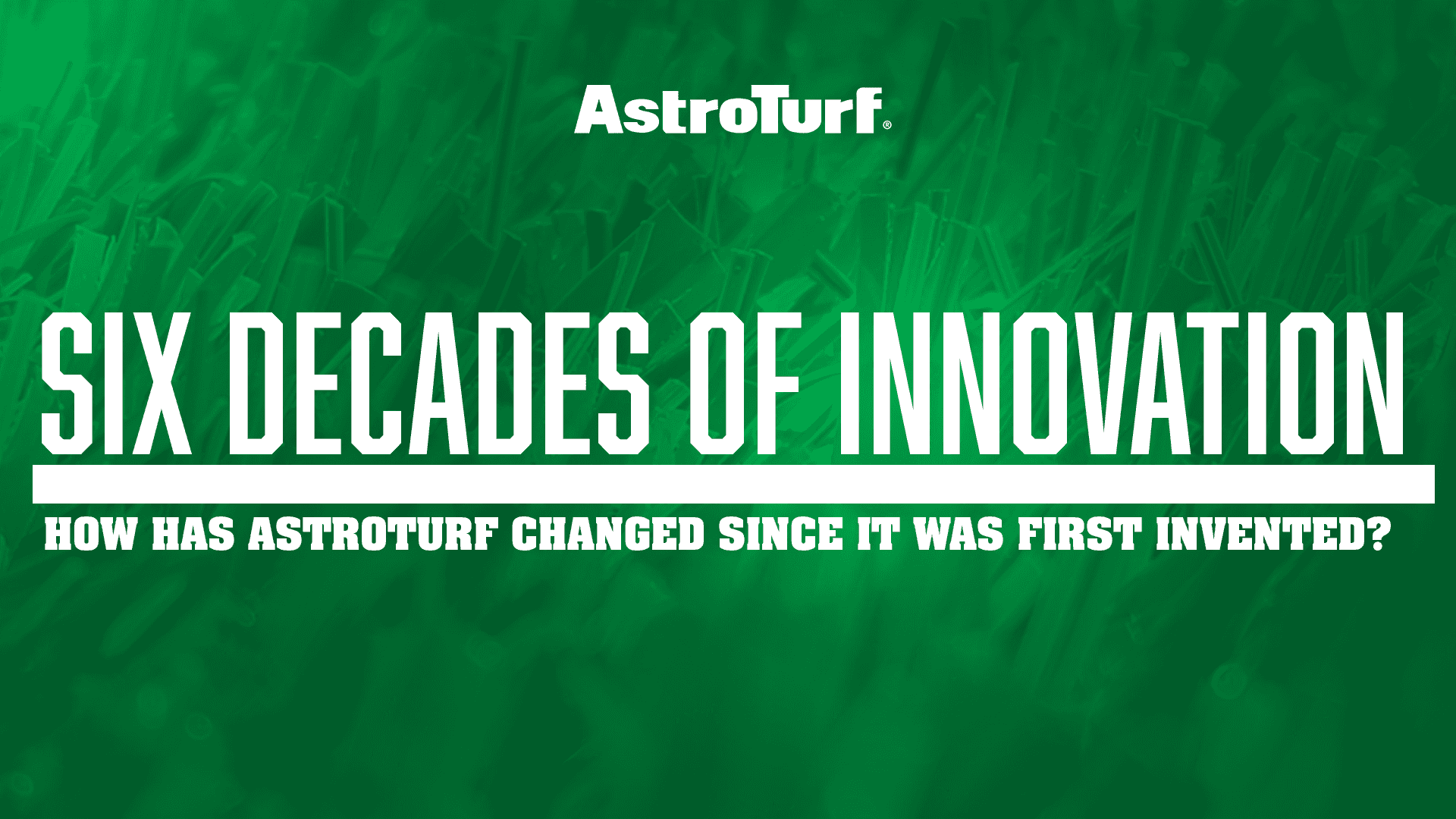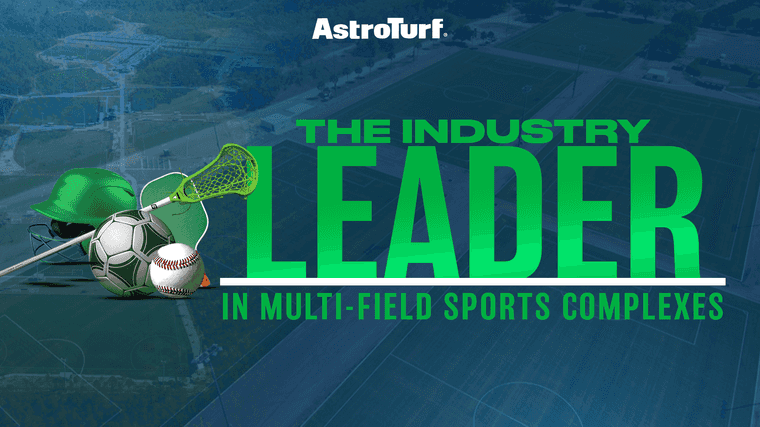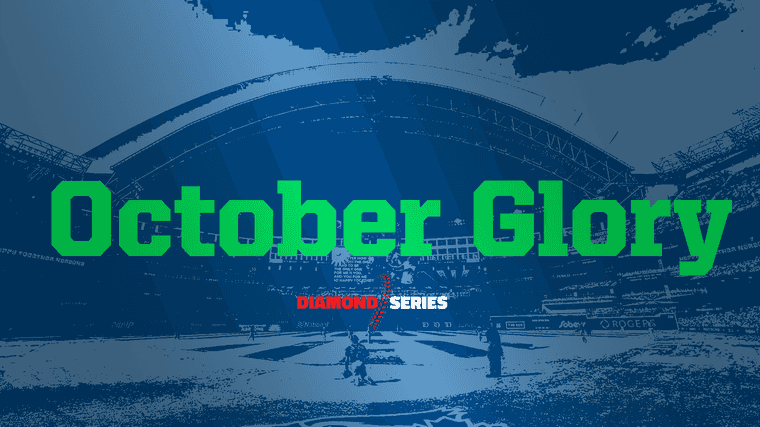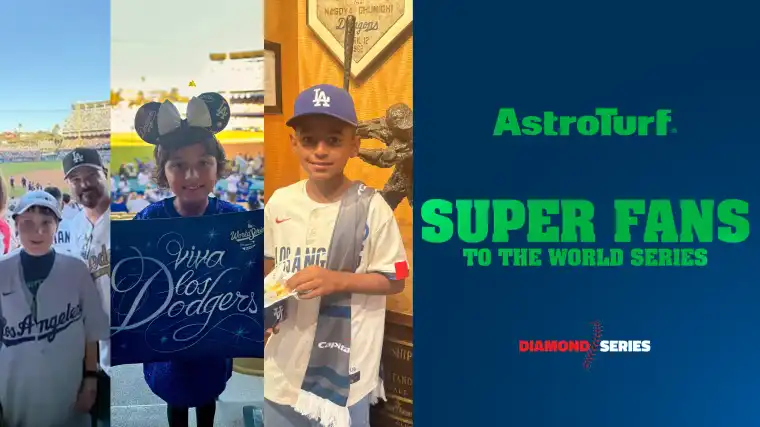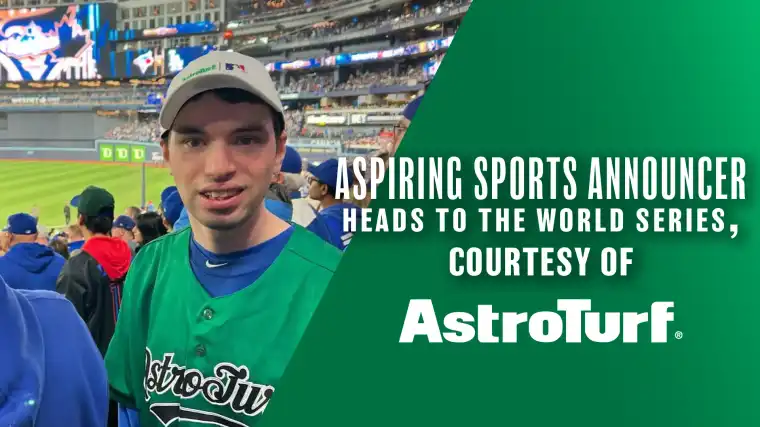The synthetic turf market includes dozens of manufacturers, each claiming superior performance and value. When facility managers, athletic directors, and homeowners evaluate options, understanding genuine performance differences proves challenging amid competing marketing claims. So what actually makes AstroTurf different from other turf brands?
Direct Answer: AstroTurf differs from other turf brands through proprietary technologies, including our patented RootZone infill retention system, Trionic Plus fiber technology, comprehensive third-party testing protocols, vertical manufacturing integration ensuring quality control, PFAS-free production, and status as the only USDA BioPreferred sports turf manufacturer with carbon-neutral product options.
These aren’t superficial marketing distinctions—they represent measurable performance advantages developed through decades of research partnerships and millions of dollars invested in innovation. Let me explain the specific technologies and practices that differentiate our products.
RootZone Technology: The Foundation of Performance Consistency
Our RootZone system represents perhaps the most significant innovation distinguishing us from competitors. This technology employs crimped nylon fibers that create a three-dimensional matrix beneath the playing surface, effectively encapsulating infill material within the turf structure.
Why Infill Retention Matters
Infill migration represents one of the most common performance problems affecting synthetic turf systems. During intensive use, traditional surfaces experience movement of infill material from high-traffic areas to less-used zones. This migration creates inconsistent playing conditions, with some areas offering excessive cushioning while others become compacted and hard.
The RootZone matrix minimizes this migration through mechanical interlocking between crimped fibers and infill particles. This design maintains uniform shock absorption and energy restitution across the entire playing surface throughout the field’s lifespan.
Independent research from Michigan State University identified RootZone technology as producing the safest biomechanical characteristics among synthetic turf systems tested. The study found that our surfaces maintained consistent performance properties that closely replicated natural grass, supporting player safety through predictable surface behavior.
Environmental and Economic Benefits
RootZone technology also addresses environmental concerns about infill leaving playing surfaces. The system keeps infill on the field rather than migrating onto adjacent areas or departing on athletes’ clothing and equipment. This retention aligns with Synthetic Turf Council guidelines for infill control, minimizing environmental impact while reducing ongoing maintenance costs associated with infill replenishment.
Competing manufacturers have attempted to replicate RootZone benefits through alternative approaches, but the specific engineering of our crimped fiber system and three-dimensional matrix structure represents proprietary technology developed through years of research and field testing.
Trionic Plus Fiber Technology: Advanced Material Science
While many manufacturers use standard polyethylene or nylon fibers, our Trionic Plus system integrates multiple advanced technologies into a single fiber platform that balances durability, comfort, and performance.
Co-Polymer Construction
Trionic Plus fibers combine co-polymers of nylon and polyethylene, creating a material that offers nylon’s superior strength and resilience while maintaining polyethylene’s softer feel that athletes prefer. This hybrid approach addresses the historical trade-off between durability and comfort that plagued earlier synthetic turf generations.
Integrated Performance Enhancements
The fiber system incorporates several proprietary technologies:
Sharkskin Technology: Reduces skin friction by approximately 30% compared to standard polyethylene fibers, addressing concerns about surface abrasiveness during sliding or falling movements. This reduction proves particularly significant for sports involving frequent player-surface contact.
Statblock Antistatic Additive: Inhibits static electricity by up to seventeen times compared to standard fibers. This reduction helps maintain infill stability by minimizing electrostatic attraction that can cause infill particles to cling to clothing or equipment. The technology also improves player comfort by eliminating uncomfortable static shocks during dry conditions.
DualChill Thermal Shield: Provides 42% improvement in infrared reflectivity compared to standard synthetic fibers. This technology slows the rate at which fibers absorb heat, reducing surface temperatures and extending fiber lifespan by minimizing thermal degradation. Facilities in warm climates particularly value this innovation.
Sanitized Antimicrobial Protection: Helps eliminate bacterial odors and prevents microbial buildup on fiber surfaces. This treatment contributes to healthier playing environments in shared athletic facilities where multiple teams use surfaces daily.
Generic turf manufacturers typically offer single-material fibers without integrated performance technologies, requiring facility operators to accept trade-offs between competing performance characteristics.
Comprehensive Testing Protocols: Beyond Basic Compliance
Testing standards separate manufacturers committed to performance validation from those meeting only minimum safety thresholds.
Third-Party Validation
We subject all systems to rigorous internal and external testing before field deployment. Our testing protocols exceed industry minimums and include:
- Berlin Athletes machine testing: Measures shock absorption, vertical deformation, and energy restitution under controlled laboratory conditions
- One Turf testing: Aligned with FIFA, World Rugby, and FIH standards, considered the gold standard in synthetic turf evaluation across multiple sports
- Accelerated wear testing: Simulates years of intensive use within compressed timeframes to validate durability claims
- Environmental stress testing: Includes UV exposure chambers, temperature cycling, and chemical resistance assessment
Many competing manufacturers limit testing to basic GMax measurements (maximum impact force) without evaluating the comprehensive range of performance characteristics affecting long-term playability and athlete experience.
Sport-Specific Research
Our twelve-year partnership with the University of Tennessee’s Department of Turf Sciences represents the industry’s most substantial investment in academic research. This collaboration produces peer-reviewed studies validating innovations before market introduction, ensuring product development follows evidence-based methodologies rather than marketing-driven claims.
This research partnership has generated hundreds of thousands of dollars in research investment, supporting comprehensive biomechanical studies, player movement analysis, and long-term performance monitoring that inform our product development priorities.
Vertical Manufacturing Integration: Quality Control at Every Stage
We control all aspects of manufacturing from initial masterbatch formulation through final field installation. This vertical integration distinguishes us from competitors who source components from multiple suppliers without comprehensive oversight of material quality or chemical composition.
Chemical Safety and Transparency
Manufacturing control proves particularly important given recent concerns about chemical additives in synthetic materials. All AstroTurf products currently manufactured are PFAS-free, and we specify that all turf ingredients be free of these substances when purchasing raw materials.
Our raw materials and finished goods have been submitted to third-party analytical chemistry laboratories and tested for 32 PFAS compounds using state-of-the-art procedures, with results showing PFAS concentrations below detectable limits. This transparency and testing commitment exceeds standard industry practice.
Many synthetic turf manufacturers cannot provide equivalent chemical safety documentation or supply chain transparency because they lack control over component sourcing and formulation processes.
Consistency Across Installations
Vertical integration ensures that installations in different geographic regions maintain identical performance characteristics. Climate-controlled prefabrication facilities allow precise assembly of field sections before transport to installation sites, minimizing variables during field construction and ensuring consistent quality regardless of location or weather conditions during installation.
Sustainability Leadership: Bio-Based Materials and Circular Economy
Environmental responsibility increasingly influences facility investment decisions, and we have established clear leadership in sustainable synthetic turf manufacturing.
USDA BioPreferred Certification
We are the only USDA BioPreferred sports turf manufacturer, a federal designation requiring products to contain verified bio-based content meeting rigorous standards. This certification represents genuine environmental commitment rather than marketing claims unsupported by third-party validation.
Carbon-Neutral Systems
Our Poligras Paris GT Zero system incorporates 80% bio-based materials derived from sustainably farmed Brazilian sugar cane. This carbon-neutral hockey turf, which featured at the Paris 2024 Olympics, saves approximately 73 tonnes of CO2 per standard pitch compared to conventional synthetic turf.
The environmental impact has been independently certified by Berlin-based DAkkS-accredited consulting company GUTcert, validating the surface as genuinely climate-neutral rather than relying on carbon offset purchases that don’t address manufacturing emissions.
End-of-Life Recycling
We have partnered with recycling companies with a goal of achieving zero landfill waste for manufacturing, installation, and end-of-life turf. This commitment to circular economy principles includes taking back old fields for recycling into new products or alternative applications.
Most synthetic turf systems end their lifecycle in landfills because manufacturers haven’t invested in recycling infrastructure or designed products with end-of-life recyclability as a design priority.
Sport-Specific Engineering: Tailored Solutions
Rather than offering one-size-fits-all products, we develop specialized systems for different sports applications, with each system engineered to address sport-specific movement patterns, impact forces, and performance requirements.
Diamond Series for Baseball
Our Diamond Series features zone-specific engineering with different fiber types and pile heights for base paths versus outfield areas. The use of nylon fibers in high-traffic areas provides realistic sliding distances—a critical safety consideration that earlier synthetic surfaces struggled to achieve.
Since 2009, more Division I college baseball programs have chosen Diamond Series systems than any other artificial turf product, demonstrating market validation of sport-specific engineering approaches.
Poligras for Field Hockey
Our Poligras systems set international standards for field hockey surfaces. AstroTurf surfaces have appeared in 75% of Olympic hockey competitions, with the International Hockey Federation certifying our systems for world championship and Olympic play.
The proprietary Turf Glide technology reduces friction between ball and surface, allowing the turf to meet FIH standards for dry play. This advancement particularly benefits regions facing water scarcity, where maintaining traditional wet hockey surfaces poses significant challenges.
Football Systems
Our football turf systems incorporate shock pad technology tailored to the sport’s high-impact characteristics. Multiple pad options allow customization of impact absorption properties to meet specific league requirements or facility preferences, with each configuration validated through laboratory testing before field approval.
Generic manufacturers typically offer limited customization options, expecting facilities to adapt their requirements to available standard products rather than engineering surfaces specifically for their applications.
Key Differentiators Summary
What sets AstroTurf apart from other turf brands:
- RootZone technology: Three-dimensional infill retention system maintaining consistent performance and reducing environmental migration
- Trionic Plus fiber system: Integrated technologies addressing abrasiveness, static, heat, and antimicrobial concerns in a single fiber platform
- Comprehensive testing: One Turf protocols exceeding basic safety minimums to validate complete performance profiles
- Vertical manufacturing: Full supply chain control, ensuring chemical safety and quality consistency
- PFAS-free production: Third-party verified freedom from concerning chemical additives
- Sustainability leadership: Only USDA BioPreferred sports turf manufacturer with carbon-neutral product options
- Sport-specific engineering: Tailored systems for baseball, hockey, and football, rather than generic one-size-fits-all approaches
- Research investment: Multi-year university partnerships producing peer-reviewed validation of innovations
- Proven track record: Surfaces in twelve World Series, eleven Super Bowls, and ten Olympics, demonstrating elite performance capabilities
Frequently Asked Questions
How can I verify that a field uses genuine AstroTurf rather than generic synthetic turf?
Fields using our systems typically display branding or logos indicating our products. Facility managers can provide manufacturer documentation. The presence of certain visible technologies like RootZone fibers may indicate our systems, though definitive identification requires manufacturer specifications.
Are AstroTurf systems more expensive than other synthetic turf brands?
Our systems typically carry premium pricing reflecting advanced technologies, superior materials, and comprehensive testing. However, total cost of ownership calculations often favor our products due to longer lifespan (8-10 years versus 5-7 for generic alternatives), reduced maintenance requirements, and better performance retention throughout the warranty period.
Do professional sports teams specifically request AstroTurf or just any synthetic turf?
Professional organizations typically specify particular brands and systems meeting their performance requirements. Our position as MLB’s Official Synthetic Turf partner and presence in 75% of Olympic hockey competitions demonstrates that elite sports organizations choose us specifically rather than accepting generic alternatives.
What happens to old AstroTurf fields when they’re replaced?
We have established recycling partnerships to reclaim end-of-life turf for recycling into new products or alternative applications. This circular economy approach contrasts with industry standard practice, where old synthetic turf typically ends up in landfills.
How does AstroTurf compare to hybrid grass-synthetic systems?
Hybrid systems combine natural grass with synthetic reinforcement, offering different advantages than complete synthetic surfaces. Our systems provide superior durability, weather resistance, and maintenance simplicity compared to hybrids, which require intensive ongoing care. The choice depends on specific facility priorities and budget considerations.
Can other manufacturers use the technologies that make AstroTurf different?
Key technologies, including RootZone and specific Trionic Plus features, represent patented or proprietary innovations that competitors cannot replicate. While some manufacturers attempt similar approaches, the specific engineering and material formulations remain unique to our products.
Innovation That Defines Leadership
The question “What makes AstroTurf different?” extends beyond listing proprietary technologies to examining our fundamental approach to product development. While competitors focus on matching price points or making incremental improvements to existing designs, we invest in research partnerships, sustainable materials, and comprehensive testing that advance entire product categories.
Our six-decade history in synthetic turf innovation reflects an ongoing commitment to genuine performance advantages rather than relying on brand recognition established through historical market dominance. The technologies differentiating us today—RootZone, Trionic Plus, carbon-neutral materials, PFAS-free production—didn’t exist even fifteen years ago, demonstrating continuous evolution rather than static product offerings trading on legacy reputation.
When facilities choose our systems, they’re selecting measurable performance advantages validated through independent research and proven through installation in elite sports venues worldwide. These distinctions matter not as marketing abstractions but as concrete factors affecting athlete safety, facility economics, and environmental responsibility.
The synthetic turf industry continues evolving, with competitors constantly introducing new products and making performance claims. What separates genuine innovation from marketing positioning becomes clear through examination of research investment, testing protocols, manufacturing transparency, and sustainable practices. In each category, we maintain leadership positions that justify our market position through demonstrable advantages rather than brand legacy alone.
Understanding what makes us different empowers informed decision-making about synthetic surface investments. Whether evaluating options for professional sports facilities, collegiate athletic programs, municipal fields, or residential applications, recognizing substantive performance differences between manufacturers ensures investments deliver expected results throughout product lifecycles.
